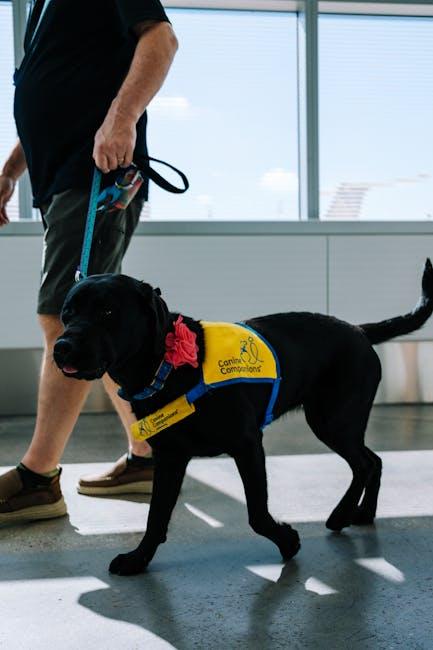In a world where stress and anxiety often lurk in the shadows of our daily routines, the presence of a comforting companion can make all the difference. Enter the emotional support animal (ESA)—a loyal ally offering solace and calm to those navigating the turbulent waters of mental health challenges. As society becomes more attuned to the nuances of mental well-being, a pivotal question emerges: Should emotional support animals be welcomed into more public spaces? This exploration delves into the heart of the matter, weighing the benefits and potential challenges of expanding access to these furry confidants. Join us as we unravel the complexities of companionship and public accessibility in the realm of mental health support.
Understanding the Role of Emotional Support Animals in Mental Health
Emotional support animals (ESAs) have become an integral part of mental health therapy, offering comfort and companionship to individuals facing various psychological challenges. These animals are not just pets; they serve as vital allies in managing conditions like anxiety, depression, and PTSD. Their presence can help alleviate symptoms, providing a calming effect that traditional therapies might not achieve alone. ESAs are distinct from service animals as they do not require specialized training to perform tasks related to a disability. Instead, their primary role is to offer emotional comfort and support through their presence.
Allowing ESAs in more public spaces could significantly enhance the well-being of those who rely on them. However, this proposal comes with its own set of challenges and considerations. Here are some potential benefits and concerns:
- Benefits:
- Increased accessibility to therapeutic support outside the home.
- Reduction in anxiety and stress in public environments.
- Promotion of social interaction and reduced isolation.
- Concerns:
- Potential for misuse of ESA certifications.
- Allergies and phobias in shared spaces.
- Impact on other animals and service animals in public areas.

Navigating the Legal Landscape: Where Are Emotional Support Animals Currently Allowed
Understanding the current legal framework for emotional support animals (ESAs) is essential for anyone advocating for broader access. Airlines have specific policies under the Air Carrier Access Act, often allowing ESAs in cabins, although recent changes have tightened these regulations. Housing laws, under the Fair Housing Act, generally permit ESAs in no-pet housing, offering essential support to those with mental health needs.
In public spaces, the rules are less uniform. Unlike service animals, ESAs do not have the same legal protections, leading to variability in acceptance. Here’s where ESAs are often restricted:
- Restaurants and Cafés
- Retail Stores
- Public Transportation
The evolving dialogue around mental health and accessibility continues to challenge these boundaries, urging a reconsideration of where ESAs might offer crucial support.

Balancing Rights and Responsibilities: Public Concerns and Support Animal Access
In the evolving conversation about emotional support animals (ESAs) in public spaces, finding a balance between individual rights and community responsibilities is crucial. Public concerns often center around potential disruptions, allergies, or safety issues. For instance, some fear that the presence of ESAs in restaurants or shopping centers might compromise hygiene or cause discomfort for other patrons. Additionally, there’s the question of verifying the legitimacy of an ESA, as fraudulent claims could undermine the system designed to support those genuinely in need.
On the other hand, advocates for broader ESA access argue that these animals play a vital role in managing mental health conditions. Allowing them in more public spaces can offer significant emotional relief and a sense of security to individuals who rely on them. Supporters highlight that:
- ESAs can help reduce anxiety and stress, making it easier for individuals to navigate daily activities.
- Access to ESAs in public can promote inclusivity and understanding of mental health issues.
- Proper training and certification can address concerns about behavior and safety.
Finding a middle ground that respects both the needs of ESA users and the rights of the public is essential. This may involve developing clear guidelines and policies that ensure safety and accessibility for everyone involved.

Crafting Inclusive Policies: Recommendations for Expanding Access to Support Animals
Expanding access to support animals in public spaces necessitates well-crafted policies that prioritize inclusivity and understanding. Policymakers should focus on creating guidelines that accommodate both the needs of individuals with emotional support animals (ESAs) and the concerns of the general public. This involves a careful balance of rights, responsibilities, and safety measures.
Key recommendations include:
- Clear Definitions: Establishing what qualifies as an emotional support animal and the criteria for certification.
- Training Standards: Implementing basic training requirements to ensure ESAs can behave appropriately in public settings.
- Public Education: Launching awareness campaigns to inform the public about the role and benefits of ESAs.
- Feedback Mechanisms: Creating channels for businesses and individuals to provide feedback on ESA policies, fostering continuous improvement.
By embracing these recommendations, we can foster environments where mental health support through ESAs is accessible, respectful, and beneficial for everyone involved.





